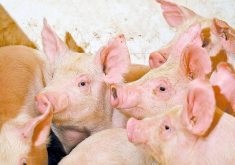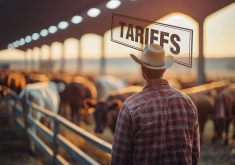Repeat Poor performance in the second litter tends to continue for the rest of the sow’s lifetime
The occurrence of “second-litter syndrome” in sows is an important measure of reproductive function in pig herds and a good indicator of likely lifetime performance, says Dr. Nicoline Soede from Wageningen University in the Netherlands.
Speaking at the recent Banff Pork Seminar, she said that the syndrome is characterized by an increased weaning-to-estrus interval, a reduced farrowing rate and lower litter size compared to first-parity sows. This is primarily related to sow body weight loss during first lactation.
Traditionally, the “second-litter dip,” as it is sometimes also called, was almost always associated with an extended weaning-to-estrus period after first weaning. But, notes Dr. Soede, today’s sows have been selected for a short wean-to-estrus interval and often only show reduced farrowing rate and litter size.
Read Also

Horns aren’t unlocking anytime soon on livestock transport standards
Standards good enough meet the definition of “humane” animal transportation still vary widely between what what industry wants, what animal rights advocates want and, between the two, what federal regulators decide is good enough.
“Recent research in France found that 38 per cent of the 842 farms studied had a second litter size of at least 0.2 piglets below that of the first-parity sows,” she said. “If sows with a wean-to-estrus interval of more than seven days and those with a farrowing rate of less than 85 per cent were included, then 79 per cent of the farms were defined as having a second-parity problem.”
The reduced reproductive efficiency of second-parity sows might also lead to early culling, Soede said. “Researchers in the Netherlands studied the relationships between failure to farrow and litter size at second parity and reproductive performance in later parities. In these data, from 45,000 sows, a total of 15.7 per cent of the second-parity sows inseminated became repeat breeders. While being a repeat breeder in second parity did not affect litter size in subsequent parities, it was associated with decreased farrowing rate in parities three and four.” Also, second-parity repeat breeder sows were, on average, culled two parities earlier (parity five versus seven, respectively) compared with non-repeat breeders, Soede said.
The study also showed that sows with a low second-parity litter size also had a smaller litter size in parity three and above, compared with sows with a moderate or large litter size at second parity.
“These data show that a large proportion of sows with poor reproductive performance in second parity are at risk of having a poor reproductive performance in subsequent parities, resulting in earlier culling,” Soede said.
Lactation weight loss
This decrease in performance is related to sow weight loss during lactation, Soede said. “One research study showed that sows with a high lactation weight loss had a similar ovulation rate, but fewer viable embryos (14.9 versus 16.8) at Day 35 of pregnancy,” she said. They also had fewer implantation sites (17.2 versus 19.5) than sows with a low lactation weight loss, which indicates increased embryo mortality before implantation at approximately Day 15 of pregnancy as a problem.”
This confirms that lactation weight loss affects embryo quality, resulting from reduced follicle and oocyte quality, she said.
“Since lactation weight loss is a crucial factor influencing reproductive performance in second-parity sows, any management solution that leads to higher lactation feed intake or reduced milk production will benefit the reproductive performance of second-parity sows,” Soede said.
She suggests a number of solutions including adequate gilt development to ensure a high feed intake capacity and a range of measures to increase lactation feed intake, such as improving water availability, optimizing room temperature to stimulate appetite and manipulation of piglet numbers and weaning age for gilt litters.
“Another approach is to allow sows time to recover from the loss of weight during lactation before they are inseminated,” Soede said. “The normal wean-to-estrus interval in contemporary sows is too short to allow for this recovery. Skipping breeding at first estrus can improve pregnancy rates by 15 per cent and subsequent litter sizes by 1.3 to 2.5 piglets, but increases the number of non-productive days by 21.”
Soede suggests that providing a shorter recovery period than a full cycle length, by administering a progesterone analogue (Altrenogest, Matrix, Merck Animal Health) post-weaning, which delays the onset of heat hormonally, might be a more economic option. Treatment until 14 days after weaning has been shown to result in consistent and substantial improvements in performance, Soede said.
In modern hybrid first-litter sows with high lactation weight losses and short weaning-to-estrus intervals, extending the period from weaning to first ovulation seems a promising route to improve reproductive performance,” she said.
Another option for reducing the impact of second-litter syndrome may be to stimulate body weight recovery during the subsequent pregnancy, Soede believes.
“During the first two-thirds of gestation, the energetic demands for litter growth are low and young sows can use this period to recover from lactation weight loss,” she said. “Recent research in the Netherlands investigated whether a 30 per cent increase in feed intake during the first month of second pregnancy increases litter size. In the first of two studies, the increased feed intake increased litter size by two piglets. However, in a second study aimed at investigating the physiological background of this increase, embryo survival was not affected.”
Based on these and other data, Soede said an increased feed intake during the first month of second pregnancy is certainly beneficial for body weight recovery and may also increase reproductive performance.
The quality of management provided to gilts and young sows has become critical due to the drastically improved reproductive potential of modern genotypes. While the impact of the second-litter syndrome may be insidious when overall performance is high, nevertheless its effect on lifetime performance and longevity makes it worthy of some renewed focus in many herds.














